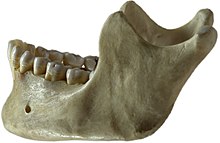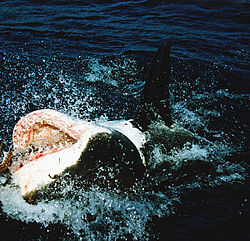Jaw

Thejawsare a pair of opposable articulated structures at the entrance of themouth,typically used for grasping and manipulating food. The termjawsis also broadly applied to the whole of the structures constituting the vault of the mouth and serving to open and close it and is part of thebody planof humans and most animals.
Arthropods[edit]

Inarthropods,the jaws arechitinousand oppose laterally, and may consist ofmandiblesorchelicerae.These jaws are often composed of numerousmouthparts.Their function is fundamentally for food acquisition, conveyance to the mouth, and/or initial processing (masticationorchewing). Many mouthparts and associate structures (such aspedipalps) are modified legs.
Vertebrates[edit]
In mostvertebrates,the jaws arebonyorcartilaginousand oppose vertically, comprising anupper jawand alower jaw.The vertebrate jaw is derived from the most anterior twopharyngeal archessupporting the gills, and usually bears numerousteeth.

Fish[edit]

The vertebrate jaw probably originally evolved in theSilurianperiod and appeared in thePlacodermfishwhich further diversified in theDevonian.The two most anteriorpharyngeal archesare thought to have become the jaw itself and the hyoid arch, respectively. The hyoid system suspends the jaw from the braincase of the skull, permitting great mobility of the jaws. While there is no fossil evidence directly to support this theory, it makes sense in light of the numbers of pharyngeal arches that are visible in extant jawed vertebrates (theGnathostomes), which have seven arches, and primitive jawless vertebrates (theAgnatha), which have nine.
The original selective advantage offered by the jaw may not be related to feeding, but rather to increased respiration efficiency.[1]The jaws were used in thebuccal pump(observable in modern fish andamphibians) that pumps water across the gills of fish or air into the lungs in the case of amphibians. Over evolutionary time the more familiar use of jaws (to humans), in feeding, was selected for and became a very important function in vertebrates. Manyteleostfish have substantially modified jaws forsuction feedingandjaw protrusion,resulting in highly complex jaws with dozens of bones involved.[2]
Amphibians, reptiles, and birds[edit]
The jaw intetrapodsis substantially simplified compared to fish. Most of the upper jaw bones (premaxilla,maxilla,jugal,quadratojugal,andquadrate) have been fused to the braincase, while the lower jaw bones (dentary,splenial,angular,surangular,andarticular) have been fused together into a unit called themandible.The jaw articulates via a hinge joint between the quadrate and articular. The jaws oftetrapodsexhibit varying degrees ofmobility between jaw bones.Some species have jaw bones completely fused, while others may have joints allowing for mobility of the dentary, quadrate, or maxilla. Thesnake skullshows the greatest degree ofcranial kinesis,which allows the snake to swallow large prey items.
Mammals[edit]
In mammals, the jaws are made up of themandible(lower jaw) and themaxilla(upper jaw). In theape,there is a reinforcement to the lower jaw bone called thesimian shelf.In the evolution of the mammalian jaw, two of the bones of the jaw structure (thearticularbone of the lower jaw, andquadrate) were reduced in size andincorporated into the ear,while many others have been fused together.[3]As a result, mammals show little or nocranial kinesis,and the mandible is attached to thetemporal boneby thetemporomandibular joints.Temporomandibular joint dysfunctionis a common disorder of these joints, characterized by pain, clicking and limitation of mandibular movement.[4]Especially in thetherian mammal,thepremaxillathat constituted the anterior tip of the upper jaw in reptiles has reduced in size; and most of the mesenchyme at the ancestral upper jaw tip has become a protruded mammaliannose.[5]
Sea urchins[edit]
Sea urchinspossess unique jaws which display five-part symmetry, termed theAristotle's lantern.Each unit of the jaw holds a single, perpetually growingtoothcomposed of crystallinecalcium carbonate.
See also[edit]
References[edit]
- ^Smith, M.M.; Coates, M.I. (2000). "10. Evolutionary origins of teeth and jaws: developmental models and phylogenetic patterns". In Teaford, Mark F.; Smith, Moya Meredith; Ferguson, Mark W.J. (eds.).Development, function and evolution of teeth.Cambridge: Cambridge University Press. p. 145.ISBN978-0-521-57011-4.
- ^Anderson, Philip S.L; Westneat, Mark (28 November 2006)."Feeding mechanics and bite force modelling of the skull of Dunkleosteus terrelli, an ancient apex predator".The Royal Society Publishing.Biology Letters.Retrieved2024-01-25.
- ^Allin EF (December 1975). "Evolution of the mammalian middle ear".J. Morphol.147(4): 403–37.doi:10.1002/jmor.1051470404.PMID1202224.S2CID25886311.
- ^Wright, Edward F. (2010).Manual of temporomandibular disorders(2nd ed.). Ames, Iowa: Wiley-Blackwell.ISBN978-0-8138-1324-0.
- ^Higashiyama, Hiroki; Koyabu, Daisuke; Hirasawa, Tatsuya; Werneburg, Ingmar; Kuratani, Shigeru; Kurihara, Hiroki (November 2, 2021)."Mammalian face as an evolutionary novelty".PNAS.118(44): e2111876118.doi:10.1073/pnas.2111876118.PMC8673075.PMID34716275.
External links[edit]
- Jawat the U.S. National Library of MedicineMedical Subject Headings(MeSH)
